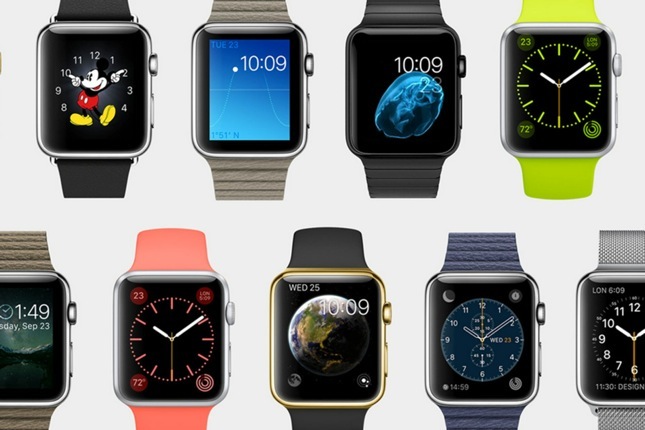Samsung heads into CES 2026 with momentum Samsung Electronics is closing out 2025 with a strong signal of where its future tech ambitions lie….
Apple Watch: all you need to know about Apple’s digital ticker

In a typically stylish Apple event held in downtown San Francisco, Apple finally launched its Apple Watch to the world after spending the past six months teasing the general public.
The Apple Watch, which will be available in two sizes (1.5-inches and 1.65-inches), three guises (average Joe, Sport and “Watch Edition”) and a plethora of strap options, will likely put a cat amongst the Huawei, Samsung and LG pigeons of the wearable world. The device, however will start at a base price of US$349 and climb to a ridiculous US$17 000 for the overly-flashy, obnoxious gold “Edition”.
Read more: Huawei Watch is probably the prettiest smartwatch ever made
Unlike the Android Wear supporters’ more affordable examples, the Apple Watch runs on a stripped down version of iOS which makes owning an iOS device of similar description imperative to the watch’s regular workings.
Right. But we know all of this from September’s launch, don’t we? So what has Apple announced that’s really any different from the previous announcement? Well lots, actually.
The apps
A smartwatch is only as good at the apps it runs and this is where the Apple Watch runs away from its competition.

Apple launched a new SDK dubbed ResearchKit that will allow those interested in conducting research using Apple’s plethora of sensors on its devices to do just that. It makes it easier to craft apps that monitor ailments like heart disease, breast cancer and Parkinson’s.
There are also the usual apps for Workouts, for notifications and the watch allows the wearer to answer phone calls through the watch itself — although you need to have that iPhone at the ready.
There are also apps for Facebook, Instagram, Pinterest, American Airlines, Uber and Alarm.com integration, which means you can set alarms and monitor your home though Apple’s HomeKit smart home system. Hotels will likely allow smart integration too using the NFC system, turning the watch into a hotel door key should you wish.
The battery life
There has been talk of the Apple Watch’s battery enjoying a briefer life than a flea on cocaine, and this is largely correct. You’ll get 18 hours of mixed use, which is nowhere near the seven days offered by the Pebble, or the one-and-a-half offered by the Moto 360 — arguably the biggest Android Wear battery hog.
Now, excuse me if I’m wondering where my “two days” of smartwatch battery life has evaporated.
Read more: 4 reasons why the Apple Watch will be a massive failure
It’s the biggest let down of the Watch without a doubt, and pretty much makes its workings and potential — regardless of how gleaming it may be — redundant. “Redundant?” I hear you exclaim loudly. Let’s put the Apple Watch’s battery into perspective.
When playing music the battery will last up to 6.5 hours and up to three hours when being used as a Bluetooth handset. Apple claims a battery life of 48 hours when its used simply as a watch and 72 hours in power saving mode… which probably turns it into an analog watch.

The accessories
Can this launch be billed as the first of its kind, melding fashion and technology in the same sphere? Yes. In fact, Apple Watch is more of a fashion statement than any of its, or any other wearable device has been before it.
There are all sorts of strap options, and the two watch sizes also allows those with smaller or larger arms to find a watch that’s comfortable. The Watch Edition version also caters for the super wealthy, with an 18-carat gold strap and boat loads of overbearing swagger. Watch out for these in hip-hop videos in the near future.
Read more: Apple’s old timey classic Watch needs to be a fashion statement in the age of tech
Apple will let users swop and change the straps too. The cheapest strap (for those of a sporty disposition) will retail for around US$49, while the big daddy cool linked metal strap will set prospective wearers back around US$449 — over US$100 more than the baseline Apple Watch itself.
The health implications
Health monitoring will become a big thing in the future (lest we forget that buzz term Big Data), and Apple wants to ensure it’s top of its class. Although not possessing the millions of sensors we were promised in previous announcements, there is a heart-rate monitor, a GPS (but piggy-backed onto the iPhone only) and a whole new way to monitor your health from the iPhone itself using HealthKit.
Sure, previously other devices used HealthKit, but now that Apple-named strap clasping to your wrist can send information directly to your iPhone.

The damage
We’ve gone over this before, but just to clarify: at US$349, it’s not the cheapest wearable in the market, but it does come with that usually-adding-US$100-to-the-price Apple name tag. The Moto 360 retails for around US$249 while the LG G Watch R (US$239), both boast a longer battery life and arguably, more aesthetic appeal. The companies are also more adept at this smartwatch thing, with Apple just about dipping its toe into the wearables pool with this device.
Would I purchase the Apple Watch? Is there a concrete reason to purchase the Apple Watch? Nope, and if you’re an Apple devotee, definitely.
The availability
The Apple Watch will be available on 24 April — that’s just over six weeks for those counting pennies in Australia, Canada, China, France, Germany, Hong Kong, Japan, the UK and the US. Pre-orders, however, are open from 10 March.
There’s no word on the Watch’s availability in other realms of the globe.
Developing…


